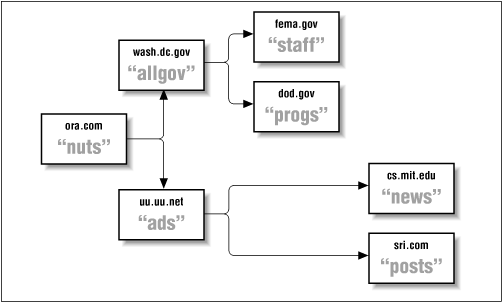 | Chapter 25 Mailing Lists and ~/.forward |  |
When mailing lists get extremely large, they sometimes include the names of other lists at other sites as recipients. Those other lists are called exploder lists, because they cause the size of a list (the number of recipients) to explode. For example, consider the situation in Figure 25.1.

This figure shows that a message sent to nuts@ora.com will, in addition to its list of users, also be forwarded to allgov@wash.gov and ads@uu.uu.net. But each of these recipients is also a mailing list. Like the original nuts list, they deliver to ordinary users and forward to other sites' mailing lists.
Unless exploding lists like this are correctly managed, problems that are both mysterious and difficult to solve can arise. A bad address in one of the distant exploding lists, for example, can cause a delivery error at a remote exploder site. If this happens, it is possible that the error notification will be sent to either the original list maintainer or (worse) the original submitter, although neither is in a position to correct such errors.
To ensure that error notification is sent to the person who is best able to handle the error, mailing list entries in the aliases file should be set up like the following. It is an approach to setting up a mailing list that is well suited for exploder sites.
list: :include:/path/to/rebroadcast.list owner-list: list-request@original.site
Here, the name of the mailing list is list and is used to
explode by sending the incoming message to the users listed
in rebroadcast.list. The envelope of the outgoing message will
contain the address list-request@original.site, thus causing
errors to be sent to the originating list maintainer rather than
wrongly to someone on the local machine.